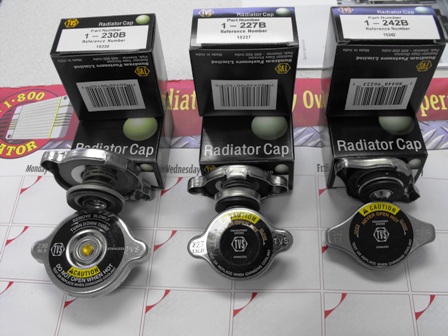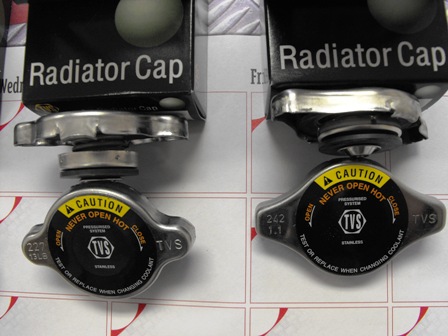In our first tech tip on radiator caps we reviewed the functions of the cap, the basic construction of a typical cap, and why one should inspect and test or replace the radiator cap when performing cooling system maintenance. In this article we will review some of the application considerations that are important when choosing the correct replacement cap.
The three key characteristics for standard metal radiators caps are:
- Size – Large, Medium, Small, Mini, Micro
- Release Pressure
- Siphon (Vacuum) Pressure
Large size caps are used for off-highway and industrial applications which require a large volume of coolant and fast fill rates. Medium caps are standard on most large truck applications. Small caps are standard on most domestic applications, light trucks and cars alike, from the 60’s through today. Mini caps are used on some smaller domestic applications and mini or micro caps are standard on most imports. Micro caps, also called Denso style caps, are standard on import applications where the OEM radiator was manufactured by Denso – Toyota, Honda, Acura, Subaru, and others.
Small Cap Mini Cap Micro Cap
Cap release pressures for original equipment applications can range from 7 PSI up to 30 PSI, with the latter being many European applications. Many late model domestic applications are now using operating pressures in the 18-20 PSI range.
Installing a cap with too low of a pressure rating can cause coolant loss, loss of coolant circulation because of pump cavitation, overheating, and engine damage. Installing a cap with too high a pressure rating may overstress the radiator, hoses, seals and other cooling system parts also leading to loss of coolant, overheating and engine damage.
Some radiator cap vacuum relief (siphon) valves are spring loaded to keep them normally closed and others rely on the coolant pressure to hold them closed. In a closed type engine cooling system, coolant expansion forces air and coolant past the radiator cap into an open reservoir for deareation and storage. When the coolant in the engine and radiator returns to ambient temperature and contracts, the vacuum created siphons coolant from the reservoir tank through the radiator cap relief valve back into the radiator. Systems which use remote pressurized systems may have caps located somewhere in the system that do not have a relief valve.
A relief valve that fails to seal properly will cause over-heating problems just like a cap with too low of a pressure rating. If the valve fails to open then the vacuum created when the coolant contracts can collapse coolant hoses or cause air to be drawn into the system. Installing a new cap with the wrong type of relief valve will also cause performance and reliability issues so always confirm not only the pressure but also the relief specifications before simply choosing a cap that fits the filler neck.
One of the most common application issues encountered relates to confusion between the “mini” and “micro” size caps. The caps may appear to be interchangeable but neither will work on filler necks designed for the other. Some aftermarket radiator manufacturers choose to use the mini cap and filler neck design to replace the micro design used on the original equipment radiator. When servicing late model Honda/Acura applications that may have OE radiators sourced from two different manufacturers the cap and filler neck designs will also be different. In an effort to reduce costs in the aftermarket offerings, most vendors will build their radiator to accept only the micro or Denso style cap. But if the vehicle has an aftermarket replacement radiator in it already, there is a risk that the old cap will not fit the new replacement radiator. Please refer to the picture below for differences between the two caps.
Mini Cap Micro Cap
The easiest way to distinguish between the mini cap on the left and micro cap on the right is to compare the top of the cap. The mini cap ears have rounded corners and the micro cap ears have more square corners. The functional difference relates to the depth from the upper sealing surface to the lower sealing surface but this is harder to recognize unless you have the two types of caps side by side to compare. It is even harder to look at the radiator filler neck and recognize which cap is needed.
In summary, always use replacement caps with the same release and vacuum pressures as the original equipment cap. And while there are rarely application issues with the standard “small” caps, there can be problems when servicing an OE or aftermarket radiator that incorporates the “mini” or “micro” cap design. In these cases, to select the correct cap, one needs to consider not only the pressures but also the filler neck design of the radiator.


Comments
bought a denso radiator #221-3131, but the new stant 13lb. radiator cap wont lock on, loose fit, should i get a motor rad 13lb cap # st-36 with a safety lever to fit tight ?? untill then what can i do ?? use duct tape to hold it down ?? please help…….. 92 Toyota camry, 4cyl, 2.2.
only two possible options for your radiator, the micro cap which is the Denso design, and the mini cap which meets the S.A.E. standards. The post explains the visual differences. If you have tried both caps and neither will fit then there is a problem with the filler neck on the radiator.